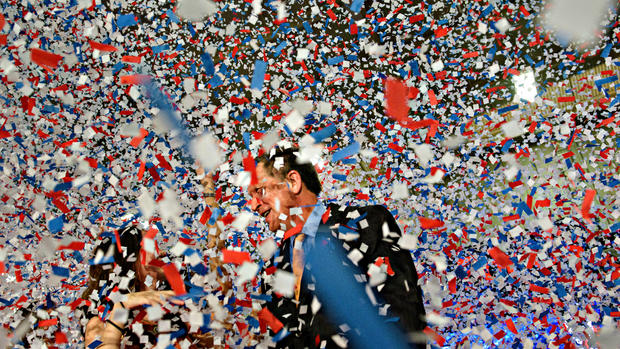Can the stock market predict who will win White House?
The big question among investors these days is not about Brexit or U.S. interest rates or the price of gold. It's about how the stock market will behave as the presidential election approaches.
It's no stretch to imagine that investors are getting edgy, considering the unprecedented political events we've all witnessed leading up the major parties' national conventions this month.
But, not to worry -- if you look at the performance of the stock market during each of 18 presidential election years going back to 1944.
According to data gathered by S&P Global Market Intelligence, presidential election years traditionally deliver "solid price performances" for the S&P 500-stock index. That's not to say such performance is all that impressive. The S&P 500 gained an average of 5.9 percent in price for the election years studied, significantly below the average price gain of 8.6 percent during for all the calendar years since 1945.
But the good news is that the frequency of a price increases during presidential elections was better: 71 percent for election years versus a 66 percent average for all years.
So with the approaching election this November, might the market pick the country's next president and commander-in-chief? Might the will of investors reflect or even predict the winner and next occupant of the White House?
Yes, said Sam Stovall, chief equity strategist at S&P Global Market Intelligence. "More times than not," he noted, "S&P 500 price returns identified whether the incumbent president, or his party [candidate], was reelected or replaced."
During presidential election years since 1944, Stovall said, "when the S&P 500 rose in price from July 31 through October 31, the incumbent person or party was reelected [or elected] 82 percent of the time." The pattern failed in 1968 and in 1980, possibly because of influential third party candidates running at the time (George Wallace in 1968 and John Anderson in 1980), Stovall points out.
Whenever the S&P 500 declined in price during those three key months, however, it signaled the replacement of the incumbent candidate or the party's candidate 86 percent of the time. This indicator failed just once, in 1956, not because Americans were uncertain of Dwight Eisenhower's reelection possibility, but more likely because of geopolitical events. Stovall recalls that late in 1956, a military response by England and France to Egypt's seizing of the Suez Canal, combined with the Soviet crushing of the Hungarian uprising, likely influenced the market's pre-election swoon.
Worth noting is the fact that the indicator did not fail in 1992 despite a notable third-party presidential candidate in Ross Perot.
At this point, with the presumptive nominees for both political parties -- Hillary Clinton for the Democrats and Donald Trump for the Republicans -- now campaigning vigorously, the heightened investor uncertainty may only be beginning. That's because the S&P 500 declined more than 3 percent by the end of the election year, "whenever neither candidate was an incumbent," Stovall noted.
But, encouragingly, "the market's return offered guidance as to the eventual victor," he adds. "The directional price change from August through October traditionally indicated whether the incumbent [or his party's candidate] would be re-elected or replaced."
What about the market's performance when a Democrat or Republican is in the White House? Has the S&P 500 performed better under one political party than another? It sure has. Since 1945, Stovall notes, the average compound annual growth rate for the S&P 500 was 3 percentage points higher during Democratic administrations, at 9.7 percent, than for Republican presidencies, at 6.7 percent.
That's a tough one to explain, Stovall acknowledged. Democrats, he offered, "have been dubbed the party of tax and spend, and spend, and spend" -- juicing economic, earnings and price performances. Republicans, on the other hand, "have been called the party of fiscal responsibility and, as a result, were required to clean up after each Democratic excess, resulting in every Republican president since William Howard Taft to endure a recession within the first two years of taking office."
But this "cynical observation is misleading," Stovall emphasized, "since many Republican presidents succeeded other Republicans, such as Taft, Coolidge, Hoover and Bush (41)." In addition, there have been three presidents since World War II who had their presidencies book-ended by recessions, and all three were Republicans (Eisenhower, Nixon/Ford and George W. Bush).
So it may be wise to leave to the political pundits the answer to the question of "why." To be sure, the stock market can signal fundamental turns during presidential elections. But with the current battle for the White House so incongruous -- in terms of the two candidates and their pronounced policies on the economy, trade, immigration, climate change, international issues and more -- the market may end up confused and unsettled in ways not seen in previous political elections.
